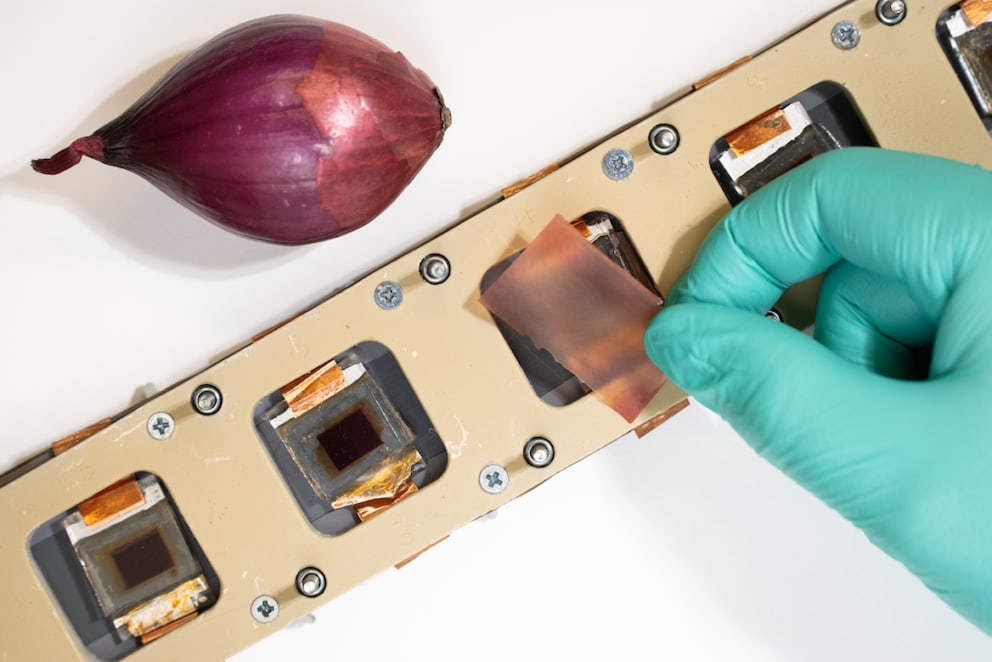June 17, 2025, 6:15 am | Read time: 3 minutes
Onions and solar energy—how do they fit together? At first glance, they don’t seem to. However, Finnish researchers have discovered that an extract from red onion skins is ideal for protecting solar cells from UV radiation, outperforming conventional plastic films. What is behind this research project?
Onion skins could play a role in improving the efficiency of solar panels in the future–specifically in terms of heat protection for the panels. A research team from the University of Turku in Finland, along with other scientists, has discovered that nano-cellulose films treated with onion skin extract offer particularly effective, bio-based UV protection for solar cells.
Onion Skins Outperform Plastic in UV Protection for Solar Panels
Solar cells are sensitive to ultraviolet radiation, which can impair their performance and lifespan. Typically, petroleum-based plastic films such as polyvinyl fluoride (PVF) or polyethylene terephthalate (PET) are used. However, scientists are increasingly working on alternatives from renewable resources.

A research team from the University of Turku and Aalto University in Finland, as well as Wageningen University in the Netherlands, has discovered that nano-cellulose treated with an extract from red onion skins is particularly effective as a UV filter. This bio-based film blocked an impressive 99.9 percent of UV radiation up to a wavelength of 400 nanometers–even outperforming a commercial PET film used as a reference product. “Nano-cellulose films treated with red onion dye are a promising option when bio-based protection is desired,” explained Rustem Nizamov, a doctoral student at the University of Turku.
Comparison of Different Bio-Based UV Filters
The study examined four different nano-cellulose films for their protective effect and long-term stability. In addition to onion skin extract, lignin and iron ions were also used–both known for their UV-absorbing properties. However, the film treated with onion dye proved to be the most effective and stable in UV protection.
Also of interest: Increased fire risk due to solar panels? Study reveals connections
Light Transmission Despite Protective Function
A crucial criterion for practical use: Solar cells need visible light and parts of the infrared spectrum (about 700 to 1200 nanometers) to generate electricity. UV rays, on the other hand, are harmful. The onion film excelled in combining protection and light transmission.
Natural substances like lignin are strong UV blockers but weaken visible light due to their dark color. Nano-cellulose dyed with onion dye showed better results. It allowed over 80 percent of light to pass through at wavelengths between 650 and 1100 nanometers.

5 Smart Home Trends for 2024 for Modern Living
Long-Term Test Under Artificial Irradiation
To test the durability of the protective effect, the films were exposed to artificial light for over 1,000 hours. This corresponds to about one year of sunlight exposure in Central Europe. The results were documented photographically, and changes in the materials and solar cells were carefully analyzed.
“The study shows how important long-term tests are for UV filters–because with other bio-based films, UV protection and light transmission changed significantly over time. For example, films treated with iron ions initially had good transmission, which decreased over time,” said Nizamov.
The study was conducted as part of the BioEST project, funded by the Academy of Finland. It was carried out by the Solar Energy Materials and Systems (SEMS) research group, which specializes in integrating solar energy into existing energy systems. The scientific results were published in February 2025 in the journal ACS Applied Optical Materials.

